Search Posts
Recent Posts
- Washington Bridge moving to 6 tight lanes – time for good situational awareness April 19, 2024
- Rhode Island Weather for April 19, 2024 – John Donnelly April 19, 2024
- Homeless in RI: Opening of Providence pallet shelter community delayed – Rhode Island Current April 19, 2024
- Outdoors in RI: Rainy days and fishing, We the People, customer service, 2A update – Jeff Gross April 19, 2024
- GriefSPEAK: Voir Dire – Mari Nardolillo Dias April 19, 2024
Categories
Subscribe!
Thanks for subscribing! Please check your email for further instructions.

Romans’ concrete made to last forever; unlike today’s planned obsolescence – David Brussat
by David Brussat, Architecture Here & There, contributing
The Pantheon, in Rome, is thought to be almost 2,000 years old. (getyourguide.com)
A number of publications have run stories describing the recent discovery of how the ancient Romans made their concrete structures last so long. For example, the dome of the Pantheon, in Rome, survives intact to this day. It is still the world’s largest dome of unreinforced concrete. And Roman aqueducts remain standing, some still transporting water slightly downhill over long distances.
Researchers found that Roman concrete contained small white chunks of lime known as lime clasts, which were treated with slaked lime to produce quicklime, which had the quality of curing and setting more quickly, thus reducing production times. But longstanding theory was that the existence of lime clasts in the concrete at many Roman sites was the result error arising from poor quality control. Researcher Admir Masic of MIT thought this might be a bit off. He told Michelle Starr of Science Alert:
The idea that the presence of these lime clasts was simply attributed to low quality control always bothered me. If the Romans put so much effort into making an outstanding construction material, following all of the detailed recipes that had been optimized over the course of many centuries, why would they put so little effort into ensuring the production of a well-mixed final product? There has to be more to this story.
After further research, his team at MIT discovered the lime clasts were a feature rather than a bug. The lime clasts also have the property of naturally expanding to fill and repair cracks that emerge in concrete over time.
At first I didn’t think this should be of any interest to me. Is it surprising that the Romans had construction methods superior to those of our own age of fake expertise? Hardly. The Romans were real people, with serious ideas on how things were and how they should be. But it occurred to me that this was exactly why we should care how they made concrete.
The key is in Masic’s use of the phrase “detailed recipes that had been optimized over the course of many centuries.” What today is “optimized” over the course of many centuries? Not much. The iPhone? After 14 model series, they still drive us crazy with their ineptitude. No. Instead of trial and error leading over time to higher quality of materials and production techniques, we seek rapid eyeblink advancements, usually assisted digitally, without the long slog of productive endeavor. To sneer at the past and its products is the big idea now. Quality control? What a concept! Planned obsolescence is more like it these days.
You can see this most directly in works of architecture. In architecture, as this discovery shows, the Romans got the big things and the little things right. Their buildings incorporated standards to ensure consistent beauty, and their concrete hardened more quickly. Pop quiz: Which is the big thing and which is the little thing? Answer: It was a trick question. Both are vital to ensuring quality. Frank Gehry’s mickled up pieces of paper don’t quite cut the mustard. Extra credit: Will today’s construction managers incorporate the techniques of Rome in modern concrete manufacture? Will they even bother to make themselves aware of these “advances”?
___
To read other articles by David Brussat: https://rinewstoday.com/david-brussat-contributing-writer/

My freelance writing and editing on architecture and others addresses issues of design and culture locally and globally. I am a member of the board of the New England chapter of the Institute of Classical Architecture & Art, which bestowed an Arthur Ross Award on me in 2002. I work from Providence, R.I., where I live with my wife Victoria, my son Billy and our cat, Gato. If you would like to employ my writing and editing to improve your work, please email me at my consultancy, [email protected], or call (401) 351-0451

